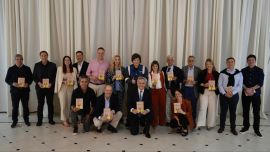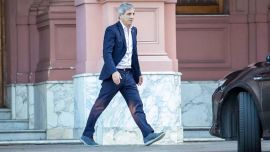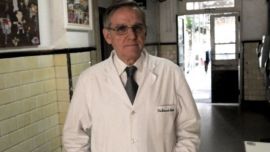The investigation into the mysterious death of 22-year-old Facundo Astudillo Castro, who left his Pedro Luro home at the end of April just over a year ago, only to show up dead 15 weeks later in mud flats of the Bahía Blanca estuary, still has various items of evidence pending.
The prosecutors attached to the case – Santa Rosa federal prosecutor Iara Silvestre, Horacio Azzolin (the prosecutor-general of the Bahía Blanca Federal Appeals Court who also heads the Fiscal Unit of Cybercrime) and Héctor Andrés Heim (from the Prosecutor’s Office for Institutional Violence) – await the results of special tests on two telephones found in Facundo’s backpack.
Investigators are convinced that someone took the backpack there after Castro’s lifeless body was found – it curiously turned up just a few metres from where the corpse was discovered, almost a month afterwards on September 12.
The tests on the phones, which consist in extracting as much information as possible via a technique known as ‘chip-off,’ has been entrusted by the prosecutors to the judicial investigators (Cuerpo de Investigaciones Judiciales) of the Buenos Aires City Prosecutor’s Office.
Apart from the damaged telephones, the backpack contained his driving licence, a peaked cap with a Ford logo and a tracksuit, which is also being submitted to studies to determine whether its state corresponds to the biodiversity of the place, the weather conditions and/or the action of third parties.
The tracksuit’s trousers were those worn by Facundo while being photographed from when detained for the first time in Mayor Buratovich, southern Buenos Aires Province. The investigators were also struck by how well preserved the backpack was, unlike the rest of the clothes inside it.
Prosecutors recognise that various question-marks persist in this case and that the forensic evidence obtained until now, the testimonial statements and the data emerging from technical analysis of the mobile telephones “are not sufficient to give a uniform and chronologically sequenced account of Facundo’s movements.”
The performance of Federal Judge María Gabriela Marrón is another key point yet to be resolved. The team of prosecutors consider her an obstacle due to her presumed lack of impartiality, because – as they understand it – she clings to an accident “as the only hypothesis.”
Prosecutors have challenged the judge but their request was rejected and they are preparing to take the case to the Federal Cassation Court. Among other complaints, investigators are puzzled as to why Marrón did not authorise the seizure of two police patrol cars that “would have passed through Origone during the hours that Facundo was in the area,” said one source.
According to investigators, Facundo was stopped by officers Mario Gabriel Sosa and Jana Curuhinca in Mayor Buratovich, kilometre 779m at 10am on April 30. The police say the 22-year-old then continued on his way to Teniente Origone, also in Villarino partido.
Key information, however, has been provided by so-called ‘Witness H’, who has given testimony saying they picked up Castro in a Honda truck on Ruta 3. He allegedly asked to be dropped off at the first railroad crossing on the way towards Bahía Blanca, because he wanted to avoid coronavirus control checkpoints.
"There are no people who have seen Facundo after Witness H," prosecutors said.
The late youngster’s mother, Cristina Castro, says she spoke with her son at 1.33pm, when he allegedly told her “she was never going to see him again.”
More than 100 days after his disappearance, on August 15, Facundo Astudillo Castro’s body was discovered. An autopsy subsequently concluded that his death had been “caused by asphyxia by submersion (drowning)."
However, the magistrate added that given "the advanced state of skeletonisation of the corpse limited the possibilities of knowing the manner of death, forensic science could not determine with scientific rigour whether it was one or another type of violent death: suicidal, homicidal or accidental."
Last week, on the one-year anniversary of Facundo’s disappearance, Crsitina Castro posted a message on Facebook, addressing her late son directly in it. "There are things that are not worth it without you," she wrote.
– TIMES/PERFIL [with reporting by Leonadro Nieva]






















Comments